中国茶文化翻译短语复习
- 格式:doc
- 大小:91.50 KB
- 文档页数:5
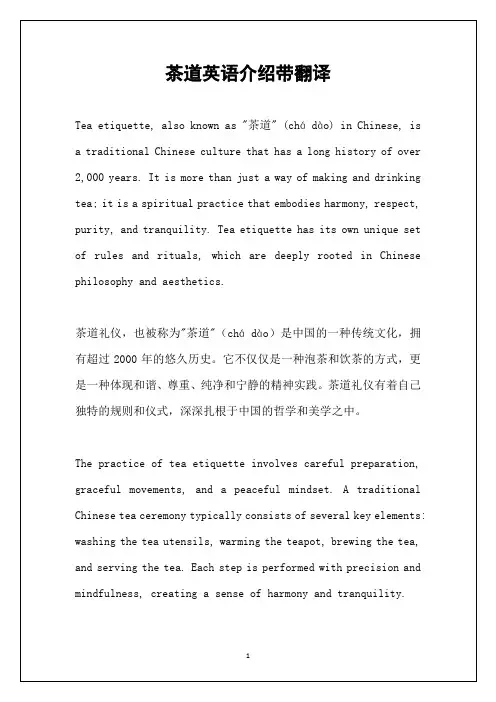
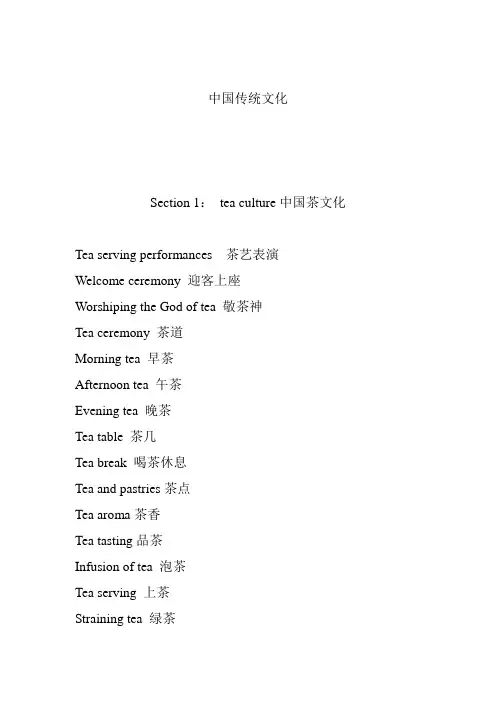
中国传统文化Section 1:tea culture中国茶文化Tea serving performances 茶艺表演Welcome ceremony 迎客上座W orshiping the God of tea 敬茶神Tea ceremony 茶道Morning tea 早茶Afternoon tea 午茶Evening tea 晚茶Tea table 茶几Tea break 喝茶休息Tea and pastries茶点Tea aroma茶香Tea tasting品茶Infusion of tea 泡茶Tea serving 上茶Straining tea 绿茶Sipping tea 呷茶First infusion of tea 头道茶Tea set 茶具Tea tray 茶盘Tea saucer茶碟Ceramic tea pot 紫砂壶Tea container 茶缸Tea caddy 茶叶罐Coaster 茶叶垫Tea strainer 滤茶器Tea spoon 茶匙Section 2:Chinese traditional festival中国传统节日Folkway 社会习俗Firecracker 鞭炮Red couplets 红对联Latern displays 灯盏Dumplings made of sweat rice 汤圆Eight treasure made of sweat rice 八宝饭Sweeping the grave 扫墓Lunar January 正月A portable light 灯笼Lion dance 舞狮Riddle written on latterns 灯谜Give new year’s greatings and visits 拜年Offer sacrifice to ancestors 祭祖Bid farewell to the old year 辞旧岁Family reunion dinner 团圆饭Dinner on New Year’s Eve 午夜饭W orship the moon god 祭月神Bless 祝福Demon 恶魔Lunar calendar农历Section 3 :Chinese ways of preserving health强身健体Barehanded boxing 徒手长拳The wielding of weapons 器械Kicking 踢Hitting 打Throwing 摔Controlling 拿Punching 击Thrusting 刺Fisting 拳打Twisting 扭身Horse stance 马步Bow stance 弓步Self defence 自我防卫External and internal work 内功和外功Self adjustment自我调整Self treatment自我治疗Palm pushing 推掌Requiredt toutine 规定的套路Sword play 剑术Spear play 枪术Reliving rigidity of muscle and joints活动筋骨Promoting the channel 舒经活络Regulating the flow of qi and blood 疏通气血Section 4:Chinese legacies 中国文化遗产Longmen grottoes 河南洛阳龙门石窟Imperial Palace of the Ming and Qing Dynasties 明清皇陵The Mogao carves 敦煌莫高窟Mausoleum of the First Qin Emperor 秦始皇陵Terracotta Warriors and Horses 兵马俑Beijing Forbidden City 北京紫禁城The temple of heaven in beijing 北京天坛Zhoukoudian site of peking man 周口店北京人遗址Dujiang weirs and qingchengshan mountain in sichuan province 四川都江堰和青城山Jiuzhaigou senic spot in sichuan province 四川九寨沟风景名胜区Wulingyuan tourist site in hunan 湖南武陵源风景名胜区Chengde summer resort and temples 承德避暑山庄Potala palace 西藏布达拉宫。
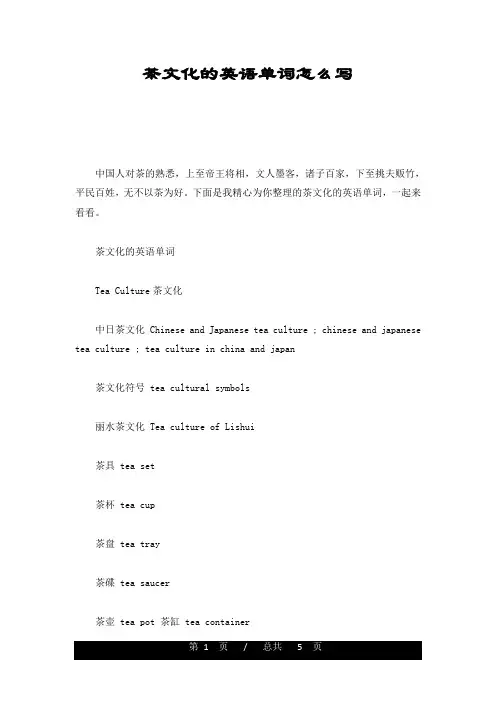
茶文化的英语单词怎么写中国人对茶的熟悉,上至帝王将相,文人墨客,诸子百家,下至挑夫贩竹,平民百姓,无不以茶为好。
下面是我精心为你整理的茶文化的英语单词,一起来看看。
茶文化的英语单词Tea Culture茶文化中日茶文化 Chinese and Japanese tea culture ; chinese and japanese tea culture ; tea culture in china and japan茶文化符号 tea cultural symbols丽水茶文化 Tea culture of Lishui茶具 tea set茶杯 tea cup茶盘 tea tray茶碟 tea saucer茶壶 tea pot 茶缸 tea container紫砂茶壶 ceramic tea pot茶叶罐 tea caddy茶杯垫 coaster 茶壶套 tea cosy 滤茶器 tea strainer茶匙 teaspoon新茶 fresh tea砖茶 brick tea毛茶 crudely tea散茶 loose tea碎茶 broken tea香片 perfumed tea茶片 tea siftings花茶 scentedjasmine tea茶叶梗 tea stale, tea stem沏新茶 making fresh tea上茶offering tea, tea serving 淡茶weak tea浓茶 strong tea抿茶 sipping tea茶园 tea garden茶馆tea house茶几 tea table茶篮 tea basket滤茶球 tea ball减肥茶 dietslimmingtea保健茶 tonic tea凉茶精 herb ingredients美容茶 cosmetic tea人参茶ginseng tea姜茶 ginger tea速溶茶instant tea茶叶蛋 salty eggs cooked in tea擂茶 mashed tea盖碗茶 tea served in a set of cups茶叶表演 tea-serving performance茶叶种类介绍1. 绿茶:茶是不经过发酵的茶,即将鲜叶经过摊晾后直接下到一二百度的热锅里炒制,以保持其绿色的特点。
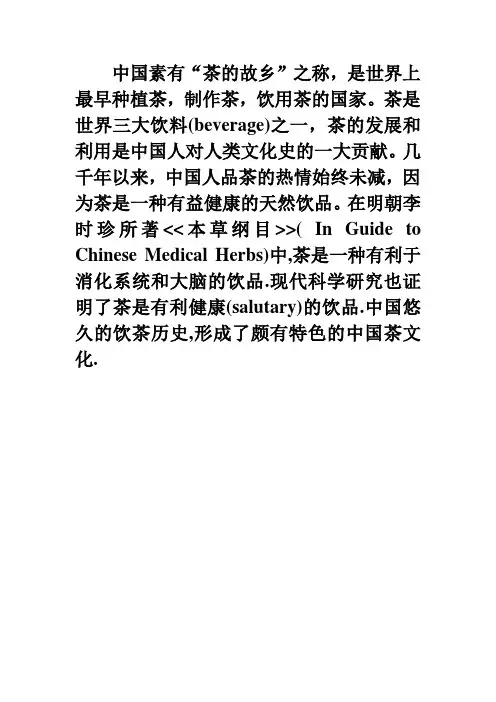
中国素有“茶的故乡”之称,是世界上最早种植茶,制作茶,饮用茶的国家。茶是世界三大饮料(beverage)之一,茶的发展和利用是中国人对人类文化史的一大贡献。几千年以来,中国人品茶的热情始终未减,因为茶是一种有益健康的天然饮品。在明朝李时珍所著<>( In Guide to Chinese Medical Herbs)中,茶是一种有利于消化系统和大脑的饮品.现代科学研究也证明了茶是有利健康(salutary)的饮品.中国悠久的饮茶历史,形成了颇有特色的中国茶文化. China, the homeland of tea, is the first country to grow, produce and drink tea. The discovery of tea, one of the three beverages of the world, is a great contribution to the history of human culture. Throughout the dynastic history in China, the enthusiasm of the Chinese people in tea drinking has remained unchanged. This is probably due to the fact that tea is a health drink. “In Guide to Chinese Medical Herbs”by Li Shizhen of the Ming dynasty. Tea is described as a drink good for our digestive system and the brain. Recent scientific analysis has also verified that tea is a salutary beverage. Over the long history of tea drinking, a special Chinese tea culture came into being. To be humane is to be a man —— From Analects of Confucius 仁者人也 Is it not pleasurable to study and practice what one learns? Is it not delightful to have friends come from afar? Is he not a gentleman who remains dignified though going unrecognized? 学而时习之,不亦说乎?有朋自远方来,不亦乐乎?人不知而不韫,不亦君子乎? —— From Analects of Confucius
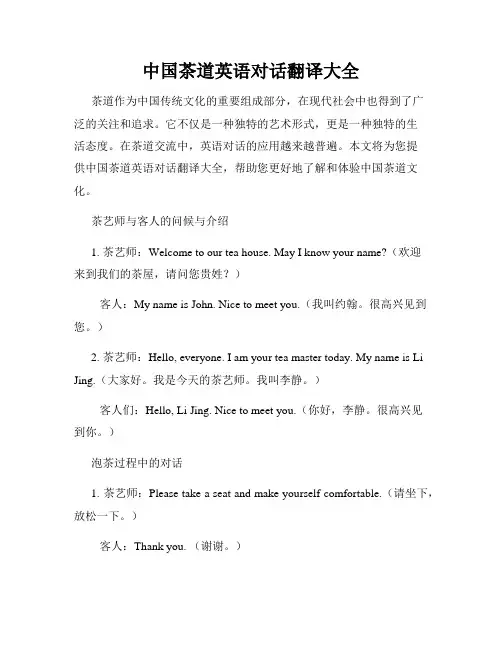
中国茶道英语对话翻译大全茶道作为中国传统文化的重要组成部分,在现代社会中也得到了广泛的关注和追求。
它不仅是一种独特的艺术形式,更是一种独特的生活态度。
在茶道交流中,英语对话的应用越来越普遍。
本文将为您提供中国茶道英语对话翻译大全,帮助您更好地了解和体验中国茶道文化。
茶艺师与客人的问候与介绍1. 茶艺师:Welcome to our tea house. May I know your name?(欢迎来到我们的茶屋,请问您贵姓?)客人:My name is John. Nice to meet you.(我叫约翰。
很高兴见到您。
)2. 茶艺师:Hello, everyone. I am your tea master today. My name is Li Jing.(大家好。
我是今天的茶艺师。
我叫李静。
)客人们:Hello, Li Jing. Nice to meet you.(你好,李静。
很高兴见到你。
)泡茶过程中的对话1. 茶艺师:Please take a seat and make yourself comfortable.(请坐下,放松一下。
)客人:Thank you. (谢谢。
)2. 茶艺师:I will start with the cleaning of the teapot.(我将从清洁茶壶开始。
)客人:That's interesting. How do you clean it?(很有趣。
你是如何清洁的?)3. 茶艺师:After cleaning, I will warm the teapot by pouring hot water into it.(清洗完毕后,我会倒热水来加热茶壶。
)客人:Why do you need to warm the teapot?(为什么需要加热茶壶?)4. 茶艺师:Warming the teapot can help to maintain the tea temperature and enhance the tea flavor.(加热茶壶可以保持茶的温度和增强茶的味道。
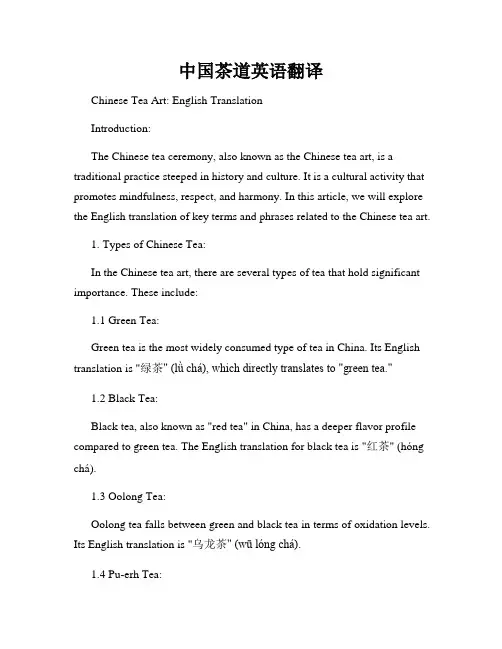
中国茶道英语翻译Chinese Tea Art: English TranslationIntroduction:The Chinese tea ceremony, also known as the Chinese tea art, is a traditional practice steeped in history and culture. It is a cultural activity that promotes mindfulness, respect, and harmony. In this article, we will explore the English translation of key terms and phrases related to the Chinese tea art.1. Types of Chinese Tea:In the Chinese tea art, there are several types of tea that hold significant importance. These include:1.1 Green Tea:Green tea is the most widely consumed type of tea in China. Its English translation is "绿茶" (lǜ chá), which directly translates to "green tea."1.2 Black Tea:Black tea, also known as "red tea" in China, has a deeper flavor profile compared to green tea. The English translation for black tea is "红茶" (hóng chá).1.3 Oolong Tea:Oolong tea falls between green and black tea in terms of oxidation levels. Its English translation is "乌龙茶" (wū lóng chá).1.4 Pu-erh Tea:Pu-erh tea is a fermented tea that is highly sought after for its unique flavor. It is translated as "普洱茶" (pǔ ěr chá) in English.2. Tea Utensils:The Chinese tea art relies on various special utensils to enhance the tea-making experience. Here are some commonly used utensils and their English translations:2.1 Gaiwan:A gaiwan is a lidded bowl used for brewing and drinking tea. Its English translation is simply "盖碗" (gài wǎn), which means "covered bowl."2.2 Tea Tongs:Tea tongs, or "夹子" (jiá zi) in Chinese, are small utensils used for handling hot tea cups or tea leaves.2.3 Tea Tray:A tea tray, known as "茶盘" (chá pán) in Chinese, typically made of wood or bamboo, is used to collect water during tea brewing and to prevent spillage.2.4 Tea Scoop:A tea scoop, referred to as "茶勺" (chá sháo) in Chinese, is a small tool for measuring and transferring tea leaves.3. Tea Ceremony Phrases:The Chinese tea art has its own set of phrases that are used during the tea ceremony. Here are a few commonly used phrases along with their English translations:3.1 "请品茶" (qǐng pǐn chá) - "Please taste the tea."This phrase is often used by the tea host to invite guests to experience the tea.3.2 "香气扑鼻" (xiāng qì pū bí) - "Fragrant aroma."This phrase is used to describe the delightful fragrance of the tea.3.3 "慢慢品尝" (màn màn pǐn cháng) - "Savor it slowly."This phrase reminds guests to enjoy the tea slowly and appreciate its flavors.4. Tea Appreciation:In the Chinese tea art, tea appreciation involves more than just tasting the tea. It encompasses understanding the tea's history, production, and cultural significance. Some key phrases for tea appreciation include:4.1 "观色" (guān sè) - "Observe the color."By examining the color of the tea, one can gain insights into its quality and brewing techniques.4.2 "闻香" (wén xiāng) - "Smell the aroma."The aroma of the tea leaves provides a glimpse into their quality and processing methods.4.3 "品味" (pǐn wèi) - "Taste the flavor."Tasting the tea allows one to fully experience its flavors, ranging from sweet to bitter or mellow.Conclusion:The Chinese tea art has a rich vocabulary of terms and phrases that are an integral part of the tea-making experience. Understanding the English translations of these terms and phrases helps in promoting the art of Chinese tea and sharing its cultural significance with a wider audience. So, whether you are a tea enthusiast or simply curious about Chinese culture, exploring the English translations of Chinese tea terminology is a fruitful endeavor.。
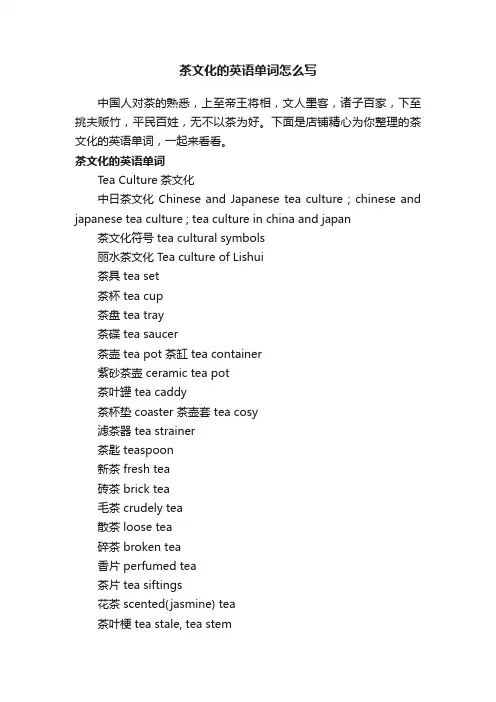
茶文化的英语单词怎么写中国人对茶的熟悉,上至帝王将相,文人墨客,诸子百家,下至挑夫贩竹,平民百姓,无不以茶为好。
下面是店铺精心为你整理的茶文化的英语单词,一起来看看。
茶文化的英语单词Tea Culture茶文化中日茶文化Chinese and Japanese tea culture ; chinese and japanese tea culture ; tea culture in china and japan茶文化符号 tea cultural symbols丽水茶文化 Tea culture of Lishui茶具 tea set茶杯 tea cup茶盘 tea tray茶碟 tea saucer茶壶 tea pot 茶缸 tea container紫砂茶壶 ceramic tea pot茶叶罐 tea caddy茶杯垫 coaster 茶壶套 tea cosy滤茶器 tea strainer茶匙 teaspoon新茶 fresh tea砖茶 brick tea毛茶 crudely tea散茶 loose tea碎茶 broken tea香片 perfumed tea茶片 tea siftings花茶 scented(jasmine) tea茶叶梗 tea stale, tea stem沏新茶 making fresh tea上茶offering tea, tea serving淡茶weak tea浓茶 strong tea抿茶 sipping tea茶园 tea garden茶馆tea house茶几 tea table茶篮 tea basket滤茶球 tea ball减肥茶 diet(slimming)tea保健茶 tonic tea凉茶精 herb ingredients美容茶 cosmetic tea人参茶ginseng tea姜茶 ginger tea速溶茶instant tea茶叶蛋 salty eggs cooked in tea擂茶 mashed tea盖碗茶 tea served in a set of cups茶叶表演 tea-serving performance茶叶种类介绍1. 绿茶:茶是不经过发酵的茶,即将鲜叶经过摊晾后直接下到一二百度的热锅里炒制,以保持其绿色的特点。
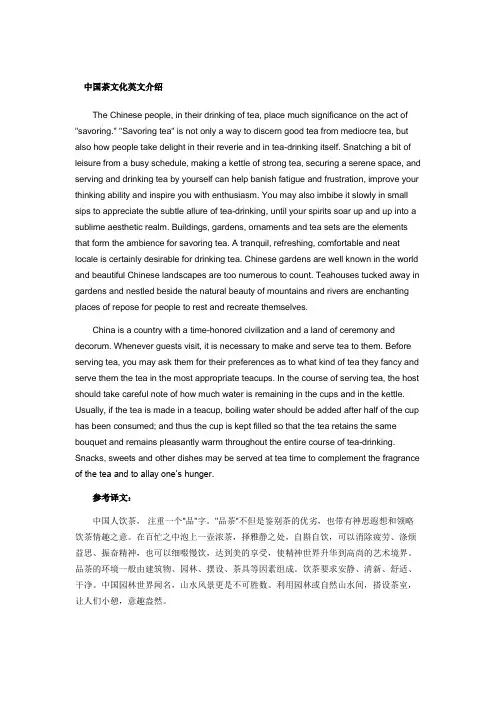
中国茶文化英文介绍The Chinese people, in their drinking of tea, place much significance on the act of "savoring." "Savoring tea" is not only a way to discern good tea from mediocre tea, but also how people take delight in their reverie and in tea-drinking itself. Snatching a bit of leisure from a busy schedule, making a kettle of strong tea, securing a serene space, and serving and drinking tea by yourself can help banish fatigue and frustration, improve your thinking ability and inspire you with enthusiasm. You may also imbibe it slowly in small sips to appreciate the subtle allure of tea-drinking, until your spirits soar up and up into a sublime aesthetic realm. Buildings, gardens, ornaments and tea sets are the elements that form the ambience for savoring tea. A tranquil, refreshing, comfortable and neat locale is certainly desirable for drinking tea. Chinese gardens are well known in the world and beautiful Chinese landscapes are too numerous to count. Teahouses tucked away in gardens and nestled beside the natural beauty of mountains and rivers are enchanting places of repose for people to rest and recreate themselves.China is a country with a time-honored civilization and a land of ceremony and decorum. Whenever guests visit, it is necessary to make and serve tea to them. Before serving tea, you may ask them for their preferences as to what kind of tea they fancy and serve them the tea in the most appropriate teacups. In the course of serving tea, the host should take careful note of how much water is remaining in the cups and in the kettle. Usually, if the tea is made in a teacup, boiling water should be added after half of the cup has been consumed; and thus the cup is kept filled so that the tea retains the same bouquet and remains pleasantly warm throughout the entire course of tea-drinking. Snacks, sweets and other dishes may be served at tea time to complement the fragrance of the tea and to allay one’s hunger.参考译文:中国人饮茶,注重一个"品"字。
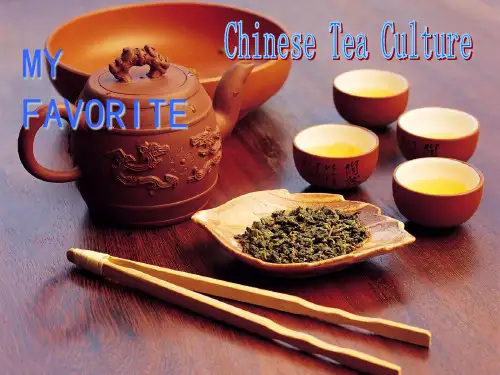
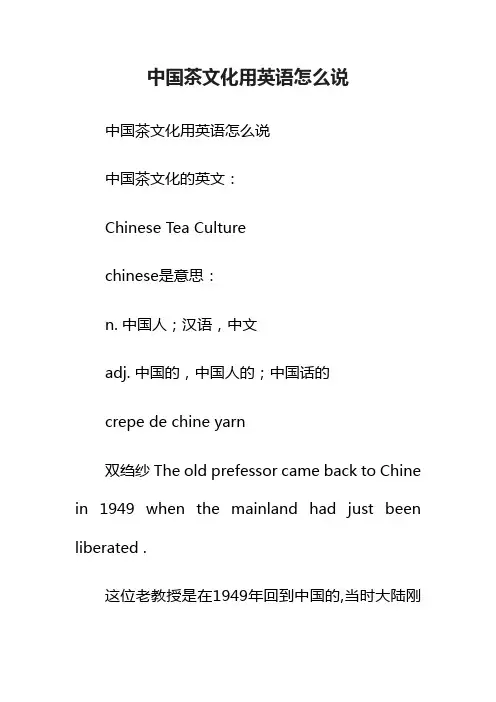
中国茶文化用英语怎么说 中国茶文化用英语怎么说 中国茶文化的英文: Chinese Tea Culture chinese是意思: n. 中国人;汉语,中文 adj. 中国的,中国人的;中国话的 crepe de chine yarn 双绉纱 The old prefessor came back to Chine in 1949 when the mainland had just been liberated . 这位老教授是在1949年回到中国的,当时大陆刚解放。Chining and embossing operations particularly require heavy pressures in order to force the metal into the design on the face of the tools. 压花、压币工序特别需要高压来强使金属形成工具面的图形。tea是什么意思: n. 茶水;茶树;茶点 v. 给…沏茶;吃茶店 The tea was all. 茶全喝光了。Is this tea sugared? 这茶放糖了吗?The caviar of tea is invaluable. 最好的茶叶价值连城。culture是什么意思: n. 文化,文明;修养;栽培,培养(物) v. 培养 This culture may interfuse with other foreign cultures. 这种文化可能与外来文化相吻合。Advancing culture is bound to triumph over declining culture. 先进的'文化必然战胜没落的文化。They are the people from diverse cultures. 他们是些有着不同文化背景的人。
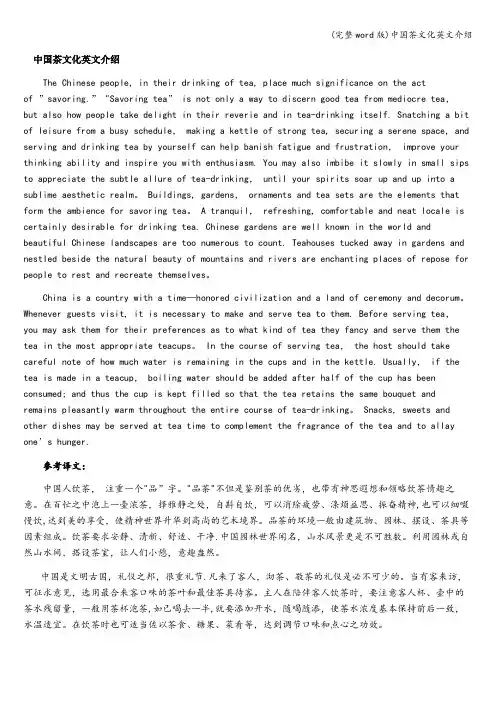
中国茶文化英文介绍The Chinese people, in their drinking of tea, place much significance on the actof ”savoring.” "Savoring tea” is not only a way to discern good tea from mediocre tea,but also how people take delight in their reverie and in tea-drinking itself. Snatching a bit of leisure from a busy schedule, making a kettle of strong tea, securing a serene space, and serving and drinking tea by yourself can help banish fatigue and frustration, improve your thinking ability and inspire you with enthusiasm. You may also imbibe it slowly in small sips to appreciate the subtle allure of tea-drinking, until your spirits soar up and up into a sublime aesthetic realm。
Buildings, gardens, ornaments and tea sets are the elements that form the ambience for savoring tea。
A tranquil, refreshing, comfortable and neat locale is certainly desirable for drinking tea. Chinese gardens are well known in the world and beautiful Chinese landscapes are too numerous to count. Teahouses tucked away in gardens and nestled beside the natural beauty of mountains and rivers are enchanting places of repose for people to rest and recreate themselves。
中国茶道英文介绍带翻译Chinese Tea Ceremony Introduction茶道是中国传统文化的重要组成部分,深受人们的喜爱和尊重。
它不仅代表了一种饮茶习俗,更是一种修身养性的艺术形式。
中国茶道带有独特的哲学理念和礼仪规范,通过精心的准备和品味,传达着对生活的热爱和追求完美的态度。
在本文中,我们将介绍中国茶道的背景、茶具、茶艺以及茶道的意义。
Background茶道起源于中国,已有数千年的历史。
古人将茶叶视为珍贵的礼品,而喝茶的过程则视为一种仪式。
茶道最早由禅宗修行者引入,并在宋朝时扩展为一种流行的饮茶文化。
茶道成为儒家文化以及贵族和士人们追求修身养性的重要方式,并渐渐发展为一种深深植根于中国社会的精致艺术形式。
Teaware中国茶道强调茶具的精细制作和品质。
茶具被视为茶道的重要组成部分,其造型、材质和工艺都在体现茶道的精神。
常用的茶具有茶壶、茶杯、茶托、茶碟等。
茶壶通常选用紫砂陶器,因其能够保持茶水的温度和味道,进而提升茶的口感和香气。
茶杯也有许多种类,其中最著名的是薄胎杯,其瓷质细腻,能够使茶汤更好地展现出色泽和香气。
Tea Artistry中国茶道以其雅致和精妙的茶艺而闻名。
茶艺师必须研究不同种类的茶叶,并掌握煮水、泡茶的技巧。
茶艺师需要根据茶叶的种类以及泡茶的时间和温度来决定如何煮水和调整泡茶的方法。
一场完美的茶道表演需要茶艺师的高超技艺和专注力。
茶艺表演通常由茶艺师在静谧的环境中进行,以确保观众能够专注地品味茶的香气和味道。
Meaning of Tea Ceremony中国茶道不仅仅是一种饮茶方式,更是一种对生活的态度和追求。
茶道强调的是沉浸于当下的意识和舒缓的心灵状态。
通过品茶,人们可以放松身心,感受茶叶的馥郁香气,体会与自然的和谐以及内心的宁静。
茶道也强调人与人之间的交流和分享。
在茶道中,人们通常会邀请亲朋好友一起品茗,共同享受茶香和友谊。
茶道通过一杯茶,将人们的心灵紧密联系在一起。
中国茶文化英文介绍The Chinese people, in their drinking of tea, place much significance on the actof "savoring." "Savoring tea" is not only a way to discern good tea from mediocre tea, but also how people take delight in their reverie and in tea-drinking itself. Snatching a bit of leisure from a busy schedule, making a kettle of strong tea, securing a serene space, and serving and drinking tea by yourself can help banish fatigue and frustration, improve your thinking ability and inspire you with enthusiasm. You may also imbibe it slowly in small sips to appreciate the subtleallure of tea-drinking, until your spirits soar up and up into a sublime aesthetic realm. Buildings, gardens, ornaments and tea sets are the elements that form the ambience for savoring tea. A tranquil, refreshing, comfortable and neat locale is certainly desirable for drinking tea. Chinese gardens are well known in the world and beautiful Chinese landscapes are too numerous to count. Teahouses tucked away in gardens and nestled beside the natural beauty of mountains and rivers are enchanting places of repose for people to rest and recreate themselves.China is a country with a time-honored civilization and a land of ceremony and decorum. Whenever guests visit, it is necessary to make and serve tea to them. Before serving tea, you may ask them for their preferences as to what kind of tea they fancy and serve them the tea in the most appropriate teacups. In the course of serving tea, the host should take careful note of how much water is remaining in the cups and in the kettle. Usually, if the tea is made in a teacup, boiling water should be added after half of the cup has been consumed; and thus the cup is kept filled so that the tea retains the same bouquet and remains pleasantly warm throughout the entire course of tea-drinking. Snacks, sweets and other dishes may be served at tea time to complement the fragrance of the tea and to allay one’s hunger.参考译文:中国人饮茶, 注重一个"品"字;"品茶"不但是鉴别茶的优劣,也带有神思遐想和领略饮茶情趣之意;在百忙之中泡上一壶浓茶,择雅静之处,自斟自饮,可以消除疲劳、涤烦益思、振奋精神,也可以细啜慢饮,达到美的享受,使精神世界升华到高尚的艺术境界;品茶的环境一般由建筑物、园林、摆设、茶具等因素组成;饮茶要求安静、清新、舒适、干净;中国园林世界闻名,山水风景更是不可胜数;利用园林或自然山水间,搭设茶室,让人们小憩,意趣盎然;中国是文明古国,礼仪之邦,很重礼节;凡来了客人,沏茶、敬茶的礼仪是必不可少的;当有客来访,可征求意见,选用最合来客口味的茶叶和最佳茶具待客;主人在陪伴客人饮茶时,要注意客人杯、壶中的茶水残留量,一般用茶杯泡茶,如已喝去一半,就要添加开水,随喝随添,使茶水浓度基本保持前后一致,水温适宜;在饮茶时也可适当佐以茶食、糖果、菜肴等,达到调节口味和点心之功效;注释:1.神思遐想:reverie;2.领略饮茶情趣:take delight in tea-drinking;3.在百忙之中泡上一壶浓茶……:这个句子较长,译者根据其意思的层次,把它分成了两个完整的句子来翻译,这样就有较大的自由度来遣词造句;4.择静雅之处:securing a serene space;5.细啜慢饮:imbibe slowly in small sips;6.达到美的享受:即"享受到饮茶之美";allure这里是名词,意为"迷人之处",也可用beauty;7.使精神世界升华到高尚的艺术境界:until your spirits soar up and up into a sublime aesthetic realm;8.利用园林或自然山水间,搭设茶室:翻译时用了tucked away和nestled,比用built要形象、优美得多;9.让人们小憩,意趣盎然:意思是"茶室是让人们休息、娱乐的迷人场所;"10.礼仪之邦:即是"一个很讲究礼仪的地方","很重礼节"为重复,不译;11.当有客来访:是"凡来了客人"的重复,可不译;根据下文的内容,加上before serving tea,使上下衔接贴切自然;12.征求意见,选用最合来客口味的茶叶和最佳茶具待客:可理解为"询问来客他们最喜欢什么茶叶,然后用最合适的茶具给客人敬茶";13.主人在陪伴客人饮茶时:译为in the course of serving tea,与前面before serving tea相呼应;14.主人在陪伴客人饮茶时……水温适宜:这句话较长,译者同样根据其意思的层次,把它分成了两个完整的句子来翻译;15.随喝随添:and thus the cup is kept filled或者and in this way the cup is kept filled;16.茶食:意思为"点心、小吃";17.达到调节口味和点心之功效:"点心"为方言"点饥、充饥"的意思;The introduction of Chinese teaThe practice of drinking tea has had a long history in China,having originated from there.The Chinese drink tea during many parts of the day such as at meals for good health or simply for pleasure.Although tea originates from China,Chinese tea generally represent tea leaves which have been processed using methods inherited from ancient China.According to popular legend,tea was discovered by Chinese Emperor Shennong in 2737 BCE when a leaf from a Camellia sinensis tree fell into water the emperor was boiling.Tea is deeply woven into the history and culture of China.The beverage is considered one of the seven necessities of Chinese life,along with firewood,rice,oil,salt,sauceclarification needed and vinegar.Some writers classify tea into four categories,white,green,oolong and black.Others add categories for red,scented and compressed teas.All of these come from varieties of the Camellia sinensis plant.Chinese flower tea 花茶,while popular,is not a true tea.Most Chinese tea is consumed in China and is not exported.Green tea is the most popular type of tea usedin China.Within these main categories of tea are vast varieties of individual beverages.Some researchers have counted more than 700.Others put the number at more than 1,000.Some of the variations are due to different strains of the Camilla plant.The popular Tie Guan Yin 铁观音,for example,is traced back to a single plant discovered in Anxi 安溪 in the Fujian province.Other teas draw some of their characteristics from local growing conditions.However,the largest factor in the wide variations comes from differences in tea processing after the tea leaves areharvested.White and green teas are heat treated shāqīng 杀青 soon after picking to prevent oxidization,often called fermentation,caused by natural enzymes in the leaves.Oolong teas are partially oxidized.Black and red teas are fully oxidized.Other differences come from variations in the processing steps.The Origins of TeaWhile references to tea in Chinese literature go back approximately 5,000 years, the origin of tea's use as a beverage is unclear.Ancient folklore places the creation of the brew at 2737 BC, when a camellia blossom drifted into a cup of boiled drinking water belonging toEmperor Shen Nung. However, most scholars credit a reference found in Erh Ya, an ancient Chinese dictionary, dated about 350 BC.Originally, tea was valued for its medicinal qualities. It has long been known that tea aids in digestion, which is why many Chinese prefer to consume it after their meal. Another interesting side effect for smokers is that tea hastens the discharge of nicotine from the body. The elevation of tea drinking to an art form began in the 8th century, with the publication of Lu Yu's "The Classic Art of Tea." The highly esteemed poet and former Buddhist priest had strict notions about the proper procedure for brewing, steeping, and serving . For example, only water from a slow-moving stream was acceptable, and the tea leaves had to be placed in a porcelain cup. The perfect milieu for enjoying the finished product was in a pavilion next to a water lily pond, preferably in the company of a desirable woman.To be fair, his work also contained several practical tips for manufacturing tea, many of which are still in use today.In the centuries following the publication of Yu's work, tea's popularity spread rapidly throughout China. Not only did tea drinking become afitting subject for books and poems; Emperors bestowed gifts of tea upon grateful recipients. Later, teahouses began dotting the landscape. While the Chinese have never developed a ritualistic ceremony surrounding tea drinking resembling the , they have a healthy respect for its role intheir daily lives.Types of TeaTea aficionados are often surprised to learn that all tea comes from the same source: the Camilla Sinensis bush. While there are hundreds are varieties of Chinese teas, most fall into four basic categories. Reputed to provide the most health benefits,is made from immature tea leaves that are picked shortly before the buds have fully opened.are not fermented during processing, and thus retain the original color of the tea leaves. The most famous green tea is the expensive Dragon Well tea, grown in the hillsides of Hanghou. Also known as "red tea," black teas are made from fermented leaves, which accounts for their darker color. Popular varietiesof black tea include Bo lei, a Cantonese tea often drunk with , and luk on - a milder tea favored by the elderly. Finally,are partially fermented, resulting in a black-green tea. Examples of oolong tea include Soi sin, a bitter tasting brew cultivated in the Fukien province.There is also a fourth category known as "scented teas," made by mixing various flowers and petals with green or oolong teas. The best known among these is jasmine tea. And , made with unripened tea leaves that are still covered with a downy, silvery fuzz, is becoming quite popular.While most of us have neither a pavilion nor a lily pond conveniently situated in our back yard, we can still indulge our penchant for this centuries-old beverage. With a little practice it's easy to brew the And budding fortune-tellers who eschewcan hone their skills in the art ofreading tea leaves.Chinese Tea Recipes- a dish that originated in Beijing's Imperial Court- In this Hunan dish duck is smoked with black tea leaves before deep-frying.More Tea Articles....- What is it that makes green tea so special- Sean Paajanen, About's Guide to Coffee and Tea, explores this ancient Chinese art.- Ever wonder why someone will tap the table three times when they want their cup refilled Learn the legend behind this charming custom.。
茶文化和茶道的英文翻译中国茶文化是中国制茶、饮茶的文化。
下面是店铺精心为你整理的茶文化和茶道的英文翻译,一起来看看。
茶文化和茶道的英文翻译茶文化tea culture茶道teaism; tea ceremony ;中国茶文化Chinese Tea Culture英国茶文化British Tea Culture茶文化的功能茶文化的社会功能主要表现在发扬茶德、传播茶道、文化艺术、修身养性、陶冶情操、促进民族团结、表现社会进步和发展经济贸易等。
茶德是经过几千年积淀下来的被历代人们所推崇的茶内在具备的美好品性。
茶文化具有的传统主要有热爱祖国、无私奉献、坚韧不拔、谦虚礼貌、勤奋节俭和相敬互让等。
吴觉农先生和湖南刘先和,为茶叶事业鞠躬尽瘁,既是爱国主义者,又是当代茶人杰出代表。
陆羽《茶经》,是古代茶人勤奋读书、刻苦学习、潜心求索、百折不挠精神的结晶。
以茶待客、以茶代酒,“清茶一杯也醉人”就是汉民族珍惜劳动成果、勤奋节俭的真实反映。
以茶字当头排列茶文化的社会功能有“以茶思源、以茶待客、以茶会友、以茶联谊、以茶廉政、以茶育人、以茶代酒、以茶健身、以茶入诗、以茶入艺、以茶入画、以茶起舞、以茶歌呤、以茶兴文、以茶作礼、以茶兴农、以茶促贸和以茶致富。
茶是中国的骄傲、民族的自尊、自信和自豪。
饮茶可以思源。
世界著名科技史家李约瑟博士,将中国茶叶作为中国四大发明(火药、造纸、指南针和印刷术)之后,对人类的第五个重大贡献。
唐代陆羽《茶经》是世界第一部茶书。
中国茶文化对世界影响功能显著。
以茶会友是茶文化最广泛的社会功能之一。
今天所处的市场经济,竞争激烈,优胜劣汰,讲利益、讲效益。
但人情较为冷漠,人际关系趋于淡漠。
通过茶楼、茶艺馆品茗或茶艺,朋友聚在一起,互通信息,交流感情,增进了解,沟通友谊。
朋友相聚在旧式茶馆里,随意说笑,回忆人生,重新享受到生命的乐趣。
古代就有“寒夜客来茶当酒”之说,以茶代酒体现传统美德,符合今天中央倡导的厉行节约制止奢侈浪费行为的规定要求。
中国茶道文化英文翻译Chinese Tea CultureChina, a country with a rich history spanning thousands of years, is the birthplace of tea and has a profound tea culture. Chinese tea culture, as a representation of the country's traditions and customs, has been influential not only in China but also around the world.1. Origins of Chinese Tea CultureThe origins of Chinese tea culture can be traced back to ancient times. According to legend, more than 4,000 years ago, the mythical Chinese emperor Shennong discovered tea when tea leaves accidentally fell into a pot of boiling water. This marked the beginning of China's love affair with tea.2. Tea in Chinese SocietyTea occupies a significant place in Chinese society. It is seen as more than just a beverage but as a way of life, a form of art, and a symbol of hospitality. In Chinese culture, drinking tea is not just about quenching thirst but about savoring the taste, appreciating the aroma, and enjoying the process of making and sharing tea.3. The Art of Chinese Tea PreparationPreparing and serving tea in China is considered an art form. The traditional Chinese tea ceremony, known as "Gongfu Cha," emphasizes the careful selection of tea leaves, precise tea brewing techniques, and the use of proper tea utensils. The tea master, who has undergone years of training,performs the ceremony with grace and precision, creating a serene and harmonious atmosphere.4. Different Types of Chinese TeaChina boasts a wide variety of teas, each with its own unique characteristics and flavors. The most famous types include green tea, such as Longjing and Biluochun, oolong tea, like Tieguanyin and Da Hong Pao, black tea, including Lapsang Souchong and Keemun, and pu-erh tea, renowned for its aging process.5. Health Benefits of Chinese TeaChinese tea is not only a delightful beverage but also renowned for its health benefits. It is believed to aid in digestion, improve metabolism, boost the immune system, and have a calming effect on the mind. Many Chinese people incorporate tea drinking into their daily routine in pursuit of a healthier lifestyle.6. Tea and Chinese PhilosophyTea has deep roots in Chinese philosophy and is often associated with harmony, balance, and tranquility. The Taoist philosophy of "wu wei," meaning "effortless action," finds expression in the spirit of tea, where simplicity and naturalness are valued. Tea drinking is seen as a way to reconnect with nature and find inner peace.7. Chinese Tea Culture around the WorldChinese tea culture has spread far beyond its borders and has gained appreciation worldwide. Chinese tea houses can now be found in manycountries, where people gather to enjoy tea, learn about its history, and experience the traditional Chinese tea ceremony. The global popularity of Chinese tea reflects its timeless charm and cultural significance.In conclusion, Chinese tea culture represents a unique blend of history, art, philosophy, and social customs. Its elegance and tranquility have captivated people for centuries. As the world becomes more interconnected, the appreciation for Chinese tea culture continues to grow, enriching the global cultural landscape.。
中国茶道英语短语翻译Chinese Tea Ceremony: Translation of English PhrasesIntroduction:The Chinese tea ceremony, known as "茶道" (chá dào), is a traditional and culturally significant practice that emphasizes the art of tea preparation, presentation, and consumption. In this article, we will explore and provide translations for various English phrases commonly used in the context of Chinese tea ceremonies.1. Greetings and Hospitality:During a tea ceremony, it is customary to greet guests and make them feel welcome. Here are some English phrases that can be used in such situations:- "Welcome! Please have a seat."Translation: "欢迎!请坐。
" (Huānyíng! Qǐng zuò.)- "Would you like some tea?"Translation: "您想要喝些茶吗?" (Nín xiǎng yào hē xiē chá ma?)- "Please enjoy the tea."Translation: "请享受这杯茶。
中国茶文化翻译短语复习
A bite of China
舌尖上的中国
a design of the square within a circle
圆中嵌方的设计
A Dream of Red Mansions,
红楼梦
a couplet
对联
ancient garden
古代园林
bamboo slips
竹简
Beijing Opera
京剧
Black tea
红茶
Chinese calligraphy
中国书法
Chinese Kongfu
中国功夫
Chinese language with its musical tones
有乐感声调的汉语
Chinese martial arts
中国武术
Cowherder and Weaver Maid
牛郎星和织女星
Double Seventh Festival
七夕节
Emperor Qin Shi Huang's Mausoleum
秦始皇陵墓
facial paintings
脸谱
farming life
田园生活
folk art (forms)
民间艺术
Four Generations under One Roof
四世同堂
Green tea
绿茶
harmony between man and nature
天人合一
Huabiao, an ornamental column
华表
idealized farming life
理想化的田园生活
ink slab
砚台
Ink wash painting
水墨画
Journey to the West
西游记
local opera
地方戏
lunar New Year's Eve
大年三十
Milky Way
银河
moon-cake
月饼
Mooring by Fengqiao at Night
枫桥夜泊
Mr. Five Willows
五柳先生
Oolong tea
乌龙茶
Pagoda of Six Harmonies
六和塔
percussion instruments
打击乐器
poems of the Tang Dynasty
唐诗
porcelain produced in Jingde County
景德镇瓷器
Potala Palace
布达拉宫
Preface to the Poems Composed at the Orchid
《兰亭集序》
Pavilion
pursuing balance and harmony
追求平衡与和谐
quick change of facial patterns
快速变脸
Red Double Happiness
红双喜
Suzhou gardens
苏州园林
table manners in China
中国餐桌礼仪
Terra Cotta Warriors
兵马俑
the architecture unique to China
具有中国特色的建
筑
The art of Chinese classical poetry
中国古典诗歌艺术
The Chinese tea culture
中国茶文化
the Confucianism sentiment
儒家思想
the crane symbolizing longevity
代表长寿的仙鹤
the Dragon-boat Festival
端午节
the end of the Qing Dynasty
清朝末年
the four treasures of the study
文房四宝
The grabbing test on a baby’s first birthday
抓周
The Grand Canal
大运河
the Great Wall
长城
the humor in cross-talk
相声中的幽默
The imperial garden
皇家园林
The invention of paper
纸的发明
the invention of chopsticks
筷子的发明
the late Shang Dynasty
商代晚期
the Lion Dance
狮子舞
the lunar calendar
农历/阴历
the mandarin ducks symbolizing
happiness
象征幸福的鸳鸯
the Mid-Autumn Day
中秋节
the mid-Shang Dynasty
商代中期
the oriental art
东方艺术
the Palace Museum
故宫
The round heaven and the square earth
天圆地方
The Silk Road
丝绸之路
the Taoist sentiment/ principles/ideas
道家思想
The Tea Classics written by Lu Yu
陆羽的《茶经》
The Teahouse
《茶馆》
The temple of Heaven
天坛
The Three Kindoms
三国
the Three Kingdom Period
三国时期
traditional culture
传统文化
writing brushes
毛笔
Yunnan Stone Forest
云南石林